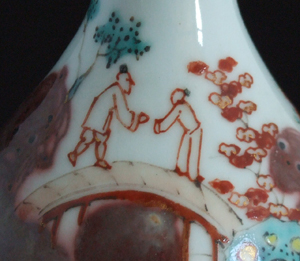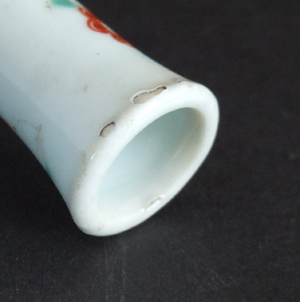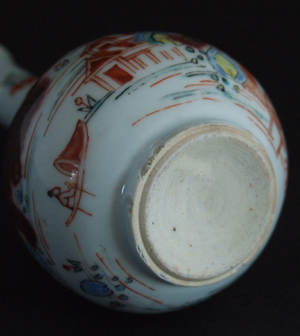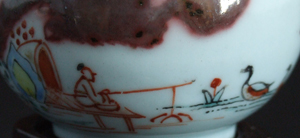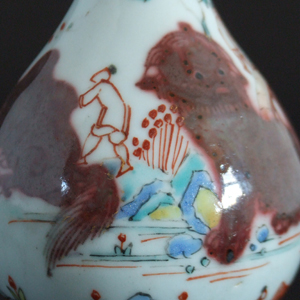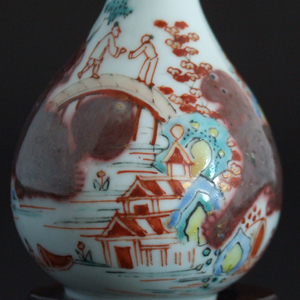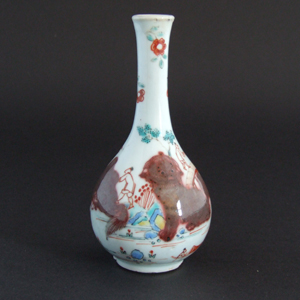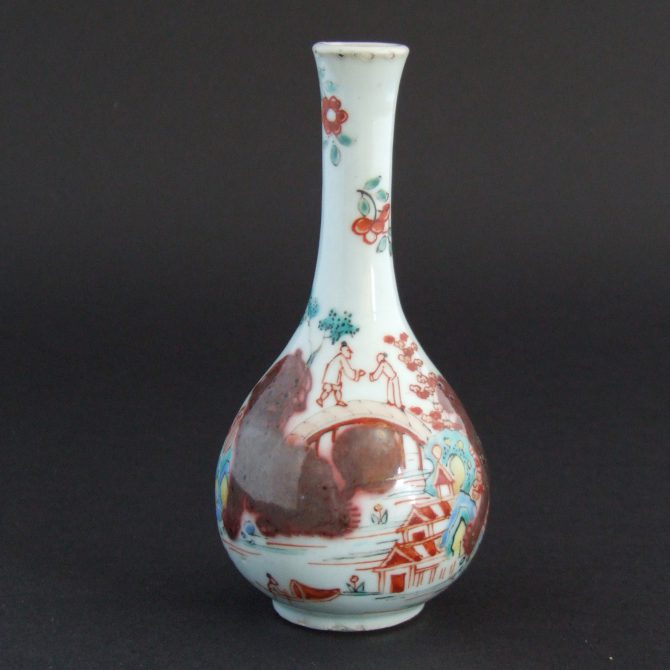
KANGXI 1662 – 1722 Dutch Decorated Chinese Porcelain
A Small Kangxi Copper-Red Bottle with Buddhist Lions, Over Decorated in Holland in a Chinoiserie Style with Two Oriental Figures Greeting Each other on a Bridge that Stretches from an Imaginary Oriental Landscape with Buildings to the Back of one of the Buddhist Lions. The Decoration was Added in the 1720`s.
This type of copper-red decoration is well know on Kangxi porcelain, despite being in Chinese taste many are known in European collections. The copper-red decoration was expensive due to it`s unreliable firing.
SOLD
- Condition
- In good condition, some burst bubbles and minor fritting to the rim.
- Size
- Height : 12.7 cm (5 inches).
- Provenance
- One of a pair of Kangxi bottles bought from James Norbury, Portobello Road, 16th March 1996. The Helen Espir Collection of European Decorated Chinese Export Porcelain : "a member of the Oriental Ceramic Society and collector, with her husband. Having made a typical collection of Song and provincial Ming blue and white, they decided to concentrate on what used to be called `clobbered` porcelain. She is the author of the standard work on the subject, European Decoration on Oriental Porcelain,2005, the first to examine the work of European decorators on Chinese porcelain throughout the eighteenth and nineteenth centuries, focusing on enamellers in Holland, Germany and England. She has learned Chinese." From Provenance ; Collectors, Dealers & Scholars : Chinese Ceramics in Britain & America (Roy Davids, Dominic Jellinek, Privately Printed, 2011. ISBN 978-0-9570148-0-0).
- Stock number
- 23662
- References
- For a larger Kangxi copper-red bottle without Dutch decoration next to a Dutch decorated example, both from the British Museum see : European Decoration on Oriental Porcelain 1700 - 1830 (Helen Espir, Jorge Welsh Books, 2005) page 92, plate 27.
Information
Fu Dog, Buddhist Lion, Fo Dog :
When Buddhist priests, or possibly traders, brought stories to China about stone dogs guarding the entry to Indian Buddhist temples, Chinese sculptors modelled statues after native dogs for use outside their temples. The mythic version of the animal, was known as the Dog of Fo, the word Fo being Chinese for Buddha. The Buddhist version of the dog was originally introduced to Han China as the protector of dharma and these dogs have been found in religious art as early as c.200 BC. Gradually they were incorporated as guardians of the Chinese Imperial dharm. However, Chinese sensitivity metamorphosed the dog into a lion, even though lions were not indigenous to China, since this seems more appropriate to the dignity of an emperor when he used the beasts to guard his gates. The mythic dog is sometimes associated with feng shui, and are often called Fu Dogs. Fu means `happiness` in Chinese; however, the term `Fu Dog` and its variant Foo Dog, are not used in Chinese. Instead, they are known as Rui Shi (`auspicious lions`) or simply Shi (lions). There are various styles of imperial guardian lions reflecting influences from different time periods, imperial dynasties, and regions of China. These styles vary in their artistic detail and adornment as well as in the depiction of the lions from fierce to serene.
